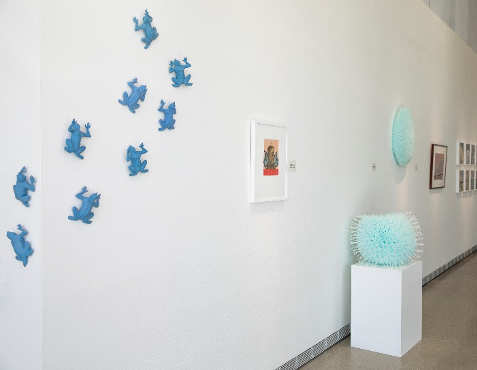
MOWA’s Mona Boulware Webb Curatorial Engagement Fellow Brianna Cole talked recently with Gloriann Langva, exhibiting artist in Magic Wilderness, on view through January 15.
Gloriann Langva is a sculptor currently based in New York. Langva earned her MFA in Studio Art–Ceramics from the University of Wisconsin–Madison. Langva’s narrative sculptures explore realms of mythology and folklore, combined with personal dreams and experiences.
“I don’t always know how to put things in words, but I can put it into a 3D object. The great thing about 3D is being able to go around the whole piece and you can hide things. I love the push pull of the viewers’ attention and forcing someone to look on the other side of the frog.”
– Gloriann Langva
Brianna Cole: Where did you go to school and what did you study?
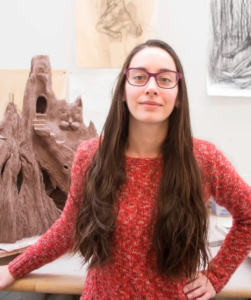
Gloriann Langva: I received my BFA from Alfred University–The New York State College of Ceramics. I started my education focusing on pottery. During an apprenticeship for Donna Polseno and Richard Hensley, I really developed my sculptural work. I considered my sculpture work as my private practice and pottery as my public practice with the thought of art vs. craft.
My mentor, Donna Polseno, would see plastic covered projects in the corner of my studio. She asked me what I was doing over there, and I said “oh, that’s my private studio.” I finally showed her that body of work, a series of naked figures performing on stages, and she asked what it was about. The performers referred to my experience of feeling like I constantly had to perform, to be someone else and show something else, rather than being comfortable in my own skin. I felt like I was always wearing a mask. My mentor was completely blown away. She said a lot of people feel this way and that I could help others feel more connected by showing emotions they don’t know how to put into words.
She told me to throw pottery out the window and focus on sculpture work. I went on to get my MFA from the University of Wisconsin–Madison. Since then, I’ve been able to do pottery and figurative sculpture, and it’s really rewarding to do both.
BC: When and why did you begin making these half-human, half-beast sculptures?
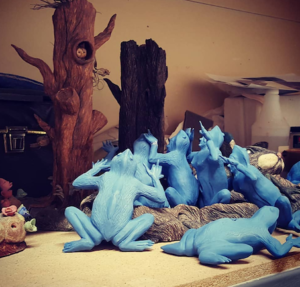
GL: The Lady Frog comes from a larger narrative that exists within my work. She’s a mythical goddess, existing in our world and watching us, hidden beneath the frog that serves as a cloak. That’s why some of the frogs are displayed with the frog side up and some with the woman side up. The Lady Frog often plays the role of midwife and goddess in my pieces. I produced them in blue porcelain from a mold. Once I cast the porcelain figure, I can cut it up and reposition the arms and legs to create different poses in my other pieces.
The Lady Frogs were also inspired by a phenomenon happening right now in the ecosystem. A crayfish in England overtook an entire river because it was able to clone itself and reproduce, making huge numbers of offspring. I was thinking about this phenomenon and what it would mean if something like that happened to women, creating an absence of male influence. How can I create this goddess in a way that addresses ideas of the patriarchy, women’s art, and women being represented without screaming it in your face? I decided to use an animal and I chose the frog because the general anatomical shape is a bit like a crouching human, which adds a creepy identifier like, “oh that could be us.”
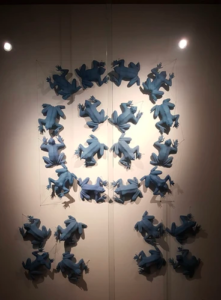
BC: What inspires the pattern or arrangement of frogs?
GL: The arrangement of frogs is based on sacred geometry coming from Hinduism and East Indian influences. I am part East Indian so a lot of my work has been influenced by East Indian motifs and art, such as gorgeous mandalas and sand paintings. The arrangement represents the universe, with small components working to create something bigger. I like that, together, they make a sculptural piece that activates the wall.
One other interesting thing about the Lady Frogs is that they can operate as a group or as a singular piece. I have one on an accent wall in my home, and I can turn them and arrange them in different ways which really activates them in that sense.
BC: Your artist statement says you combine personal narrative, mythology, and folklore. What type of mythology and folklore inspires your work? Are there any stories in particular? Do you find parallels in these stories with your own personal narrative?
GL: I like to look at folklore that is female-centric, focusing on a female struggling or a female that needs saving. In Greek mythology, there are a lot of stories that have a strong female protagonist, but there’s something off about it. The stories don’t quite make sense. I believe they were rewritten through the patriarchy.
Think about the most common version of Pandora’s Box, in which Pandora opens the box and allows all the evils to escape and infiltrate human civilization. There’s another version of the story in which, it wasn’t a box that was opened, but a ceramic jar. There’s a version where a curious man opened the box. A version even exists in which the hopes were released, not the evils.
I identify as lesbian. The term lesbian originates from a Greek poet from Lesbos: a whole society of female potters, artists, and carpenters. No one ever talks about these powerful societies of women. I’m interested in a story where women are the ones who can save themselves, rather than the armored male archetype coming in and saving the day. So, this is my opportunity to retell the stories in a way that feels empowering.
BC: Are there any other artists or influences that inspire your work?
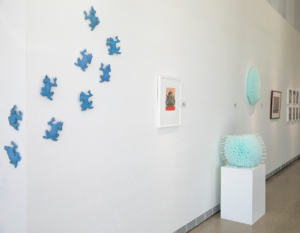
GL: I’m definitely inspired by illustration and painting. One of my professors at Madison, Fred Stonehouse, makes very illustrative and quirky work with an unsettling weirdness about it. He’s always been a huge influence for me. I also worked for Jennifer Angus, whose methods of using pattern on the wall, creating little secrets, and hiding things in the narrative were influential as well. Literature and dreams are also a source of inspiration for my work.
BC: Is there anything else you’d like to add or share about your work or experience as an artist?
You may have noticed that some of the sculptures are missing fingers. That’s just a part of the process, they’re such a small area, breakage is normal. But what would it mean if it’s just the middle finger left sticking up? So, some of them have become an “f you” to the patriarchy.
“Gloriann Langva’s work is steeped in fairytales, folklore, and mythology, with many of her figures inhabiting intricate sculpted forest settings, where mystical amalgamations of flora, fauna, and landscape are home to magical female characters. Langva’s Lady Frogs capture nature’s coexisting opposites, a prominent theme found in the exhibition Magic Wilderness. Frogs are neither wholly aquatic nor wholly terrestrial animals. Langva’s Lady Frogs further complicate the dialogue by proposing a creature that is neither wholly animal nor wholly human.”
– Curator Anwar Floyd-Pruitt
